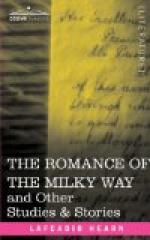The toy-shops are crammed with models of battleships,—in wood, clay, porcelain, lead, and tin,—of many sizes and prices. Some of the larger ones, moved by clockwork, are named after Japanese battleships: Shikishima, Fuji, Mikasa. One mechanical toy represents the sinking of a Russian vessel by a Japanese torpedo boat. Among cheaper things of this class is a box of colored sand, for the representation of naval engagements. Children arrange the sand so as to resemble waves; and with each box of sand are sold two fleets of tiny leaden vessels. The Japanese ships are white, and the Russian black; and explosions of torpedoes are to be figured by small cuttings of vermilion paper, planted in the sand.
* * * * *
The children of the poorest classes make their own war toys; and I have been wondering whether those ancient feudal laws (translated by Professor Wigmore), which fixed the cost and quality of toys to be given to children, did not help to develop that ingenuity which the little folk display. Recently I saw a group of children in our neighborhood playing at the siege of Port Arthur, with fleets improvised out of scraps of wood and some rusty nails. A tub of water represented Port Arthur. Battleships were figured by bits of plank, into which chop-sticks had been fixed to represent masts, and rolls of paper to represent funnels. Little flags, appropriately colored, were fastened to the masts with rice paste. Torpedo boats were imaged by splinters, into each of which a short thick nail had been planted to indicate a smokestack. Stationary submarine mines were represented by small squares of wood, each having one long nail driven into it; and these little things, when dropped into water with the nail-head downwards, would keep up a curious bobbing motion for a long time. Other squares of wood, having clusters of short nails driven into them, represented floating mines: and the mimic battleships were made to drag for these, with lines of thread. The pictures in the Japanese papers had doubtless helped the children to imagine the events of the war with tolerable accuracy.
Naval caps for children have become, of course, more in vogue than ever before. Some of the caps bear, in Chinese characters of burnished metal, the name of a battleship, or the words Nippon Teikoku (Empire of Japan),—disposed like the characters upon the cap of a blue-jacket. On some caps, however, the ship’s name appears in English letters,—Yashima, Fuji, etc.
* * * * *
The play-impulse, I had almost forgotten to say, is shared by the soldiers themselves,—though most of those called to the front do not expect to return in the body. They ask only to be remembered at the Spirit-Invoking Shrine (Sh[=o]konsha), where the shades of all who die for Emperor and country are believed to gather. The men of the regiments temporarily quartered in our suburb, on their way to




